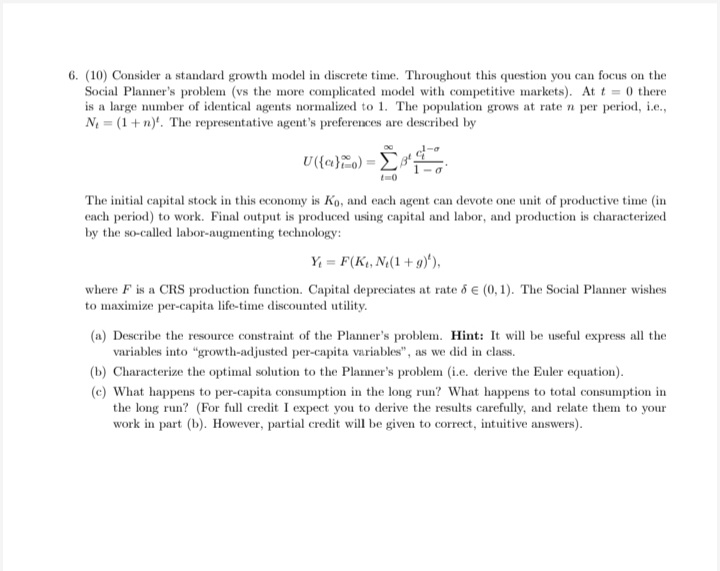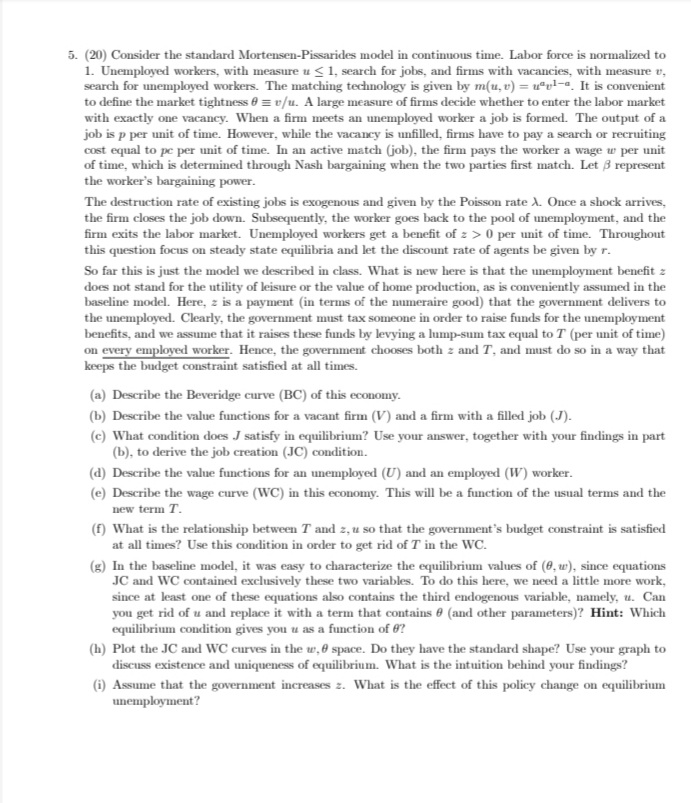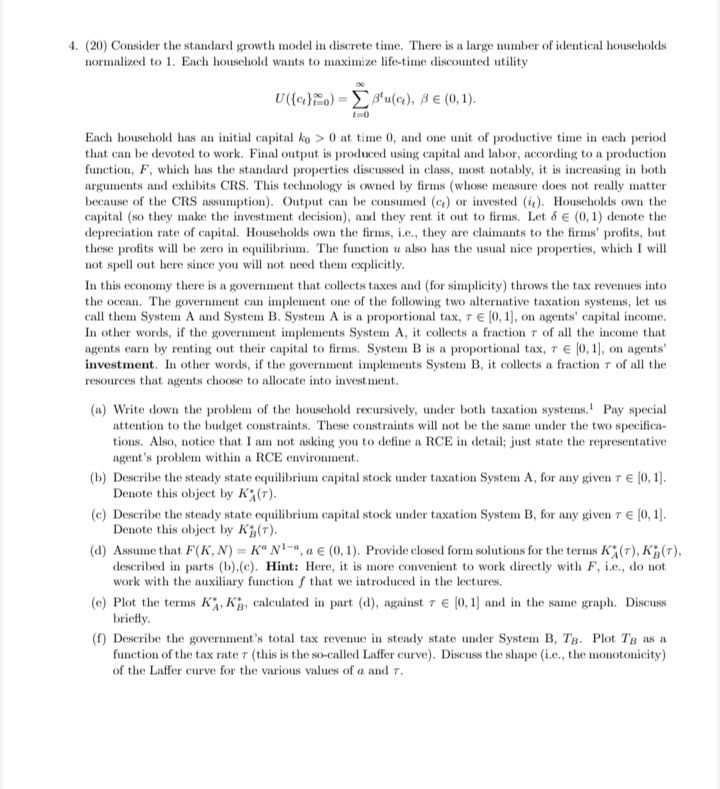


Econ 440
All the questions should be answered
6. (10) Consider a standard growth model in discrete time. Throughout this question you can focus on the Social Planner's problem (vs the more complicated model with competitive markets). At t = 0 there is a large number of identical agents normalized to 1. The population grows at rate a per period, i.e., Ne = (1 + n)'. The representative agent's preferences are described by U(a)fol = CA'S 1-0 The initial capital stock in this economy is Ko, and each agent can devote one unit of productive time (in each period) to work. Final output is produced using capital and labor, and production is characterized by the so-called labor-augmenting technology: Y = F(K, N.(1 + 9)'), where F is a CRS production function. Capital depreciates at rate & e (0, 1). The Social Planner wishes to maximize per-capita life-time discounted utility. (a) Describe the resource constraint of the Planner's problem. Hint: It will be useful express all the variables into "growth-adjusted per-capita variables", as we did in class. (b) Characterize the optimal solution to the Planner's problem (i.e. derive the Euler equation). (c) What happens to per-capita consumption in the long run? What happens to total consumption in the long run? (For full credit I expect you to derive the results carefully, and relate them to your work in part (b). However, partial credit will be given to correct, intuitive answers).5. (20) Consider the standard Mortensen-Pissarides model in continuous time. Labor force is normalized to 1. Unemployed workers, with measure u - 1, search for jobs, and firms with vacancies, with measure v, search for unemployed workers. The matching technology is given by m(u, v) = u"yl-a. It is convenient to define the market tightness o = v/u. A large measure of firms decide whether to enter the labor market with exactly one vacancy. When a firm meets an unemployed worker a job is formed. The output of a job is p per unit of time. However, while the vacancy is unfilled, firms have to pay a search or recruiting cost equal to pc per unit of time. In an active match (job), the firm pays the worker a wage w per unit of time, which is determined through Nash bargaining when the two parties first match. Let / represent the worker's bargaining power. The destruction rate of existing jobs is exogenous and given by the Poisson rate A. Once a shock arrives, the firm closes the job down. Subsequently, the worker goes back to the pool of unemployment, and the firm exits the labor market. Unemployed workers get a benefit of z > 0 per unit of time. Throughout this question focus on steady state equilibria and let the discount rate of agents be given by r. So far this is just the model we described in class. What is new here is that the unemployment benefit = does not stand for the utility of leisure or the value of home production, as is conveniently assumed in the baseline model. Here, z is a payment (in terms of the numeraire good) that the government delivers to the unemployed. Clearly, the government must tax someone in order to raise funds for the unemployment benefits, and we assume that it raises these funds by ands by levying a lump-sum tax equal to T (per unit of time) on every employed worker. Hence, the government chooses both z and 7, and must do so in a way that keeps the budget constraint satisfied at all times. (a) Describe the Beveridge curve (BC) of this economy. (b) Describe the value functions for a vacant firm (V) and a firm with a filled job (J). (c) What condition does J satisfy in equilibrium? Use your answer, together with your findings in part (b), to derive the job creation (JC) condition. (d) Describe the value functions for an unemployed (U) and an employed (W) worker. (e) Describe the wage curve (WC) in this economy. This will be a function of the usual terms and the new term T. (f) What is the relationship between T and z, u so that the government's budget constraint is satisfied at all times? Use this condition in order to get rid of T in the WC. (g) In the baseline model, it was easy to characterize the equilibrium values of (0, w), since equations JC and WC contained exclusively these two variables. To do this here, we need a little more work, since at least one of these equations also contains the third endogenous variable, namely, u. Can you get rid of u and replace it with a term that contains 0 (and other parameters)? Hint: Which equilibrium condition gives you u as a function of e? (h) Plot the JC and WC curves in the w, space. Do they have the standard shape? Use your graph to discuss existence and uniqueness of equilibrium. What is the intuition behind your findings? (i) Assume that the government increases z. What is the effect of this policy change on equilibrium unemployment?4. (20) Consider the standard growth model in discrete time. There is a large number of identical households normalized to 1. Each household wants to maximize life-time discounted utility U(falo) = Eau(a), BE (0, 1). Each household has an initial capital ko > 0 at time 0, and one unit of productive time in each period that can be devoted to work. Final output is produced using capital and labor, according to a production function, F, which has the standard properties discussed in class, most notably, it is increasing in both arguments and exhibits CRS. This technology is owned by firms (whose measure does not really matter because of the CRS assumption). Output can be consumed (c) or invested (). Households own the capital (so they make the investment decision), and they rent it out to firms. Let & e (0, 1) denote the depreciation rate of capital. Households own the firms, i.e., they are claimants to the firms' profits, but these profits will be zero in equilibrium. The function a also has the usual nice properties, which I will not spell out here since you will not need them explicitly. In this economy there is a government that collects taxes and (for simplicity) throws the tax revenues into the ocean. The government can implement one of the following two alternative taxation systems, let us call them System A and System B. System A is a proportional tax, T E [0, 1], on agents' capital income. In other words, if the government implements System A, it collects a fraction r of all the income that agents earn by renting out their capital to firms. System B is a proportional tax, 7 6 [0, 1], on agents' investment. In other words, if the government implements System B, it collects a fraction r of all the resources that agents choose to allocate into investment. (a) Write down the problem of the household recursively, under both taxation systems.' Pay special attention to the budget constraints. These constraints will not be the same under the two specifica- tions. Also, notice that I am not asking you to define a RCE in detail; just state the representative agent's problem within a RCE environment. (b) Describe the steady state equilibrium capital stock under taxation System A, for any given T E [0, 1]. Denote this object by KA(r). (c) Describe the steady state equilibrium capital stock under taxation System B, for any given 7 e [0, 1]. Denote this object by KE(T). (d) Assume that F(K, N) = K" NI-", a E (0, 1). Provide closed form solutions for the terms KA(T), KE(T), described in parts (b),(c). Hint: Here, it is more convenient to work directly with F, i.e., do not work with the auxiliary function f that we introduced in the lectures. (e) Plot the terms KA, Ky, calculated in part (d), against 7 6 [0, 1] and in the same graph. Discuss briefly. (f) Describe the government's total tax revenue in steady state under System B, Ts. Plot To as a function of the tax rate 7 (this is the so-called Laffer curve). Discuss the shape (i.e., the monotonicity) of the Laffer curve for the various values of a and T












